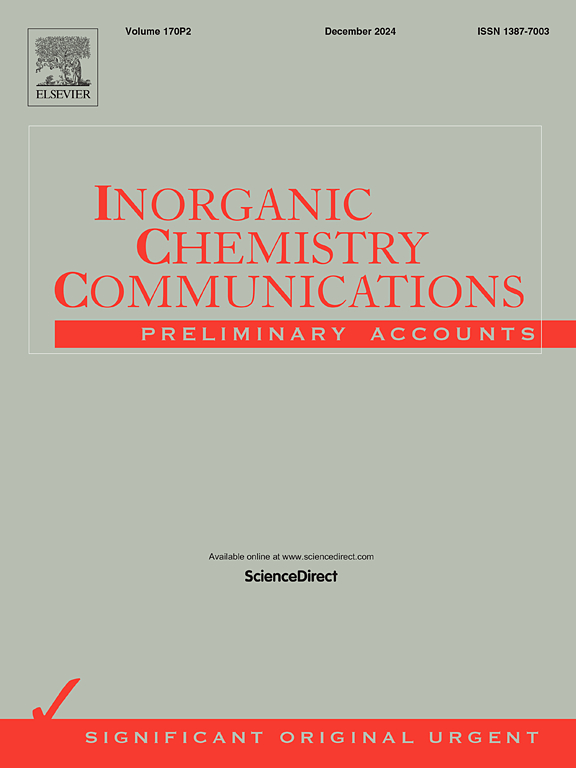Enhanced photovoltaic performance using one-dimensional polyaniline nanowires decorated with two-dimensional tungsten disulfide nanoflakes as a binary composite counter electrode for solar cell studies
IF 5.4
3区 化学
Q1 CHEMISTRY, INORGANIC & NUCLEAR
引用次数: 0
Abstract
In this work, the poly (aniline) decorated tungsten sulfide (1D PANI@2D WS2) composite was prepared as a counter electrode (CE) for dye-sensitized solar cell (DSSC) studies. FE-SEM images showed that 2D WS2 displayed a flower-like structure, and 1D PANI exhibited a fiber like-structure, while the 1D PANI@2D WS2 composite appeared as a 1D PANI polymer covered flower-like structure of 2D WS2. TEM images further confirmed that 1D PANI nanofibers were surrounding the flower-like tungsten sulfide. XRD pattern analysis indicated that the as-prepared 1D PANI@2D WS2 composite possessed an octahedral crystalline structure, with an average crystanillity of 63.49 %. The CV studies of composite demonstrated enhanced electrocatalytic activity for iodide/tri-iodide (I−/I3−) regeneration at the CE surface. Additionally, the EIS studies revealed that the 1D PANI@2D WS2 composite CE exhibited the high electrical conductivity of 6.23 × 10−3 Scm−1. DSSCs assembled the 2D WS2, 1D PANI, 1DPANI@2D WS2 composite, and Pt as CEs, with N719 dye soaked TiO2 NPs as photo-anode. The 1-butyl-3-methylimidazolium iodide, potassium iodide, iodine, and poly (ethylene oxide) used as electrolyte medium. Among these DSSC device, the 1D PANI@2D WS2 composite CE achieved an efficiency of 7.28 %. The reproducibility studies of the binary composite CE was conducted over approximately 30 days. After this period, the composite CE achieved an efficiency of 6.24 %. Furthermore, the maximum incident photon-to-charge carrier efficiency (IPCE) for the DSSCs utilizing the 1D PANI@2D WS2 composite CE was recorded at 73.21 %, surpassing the 66.12 % efficiency of the DSSC with the Pt CE.

利用二维二硫化钨纳米片修饰的一维聚苯胺纳米线作为二元复合对电极,提高了太阳能电池的光伏性能
本文制备了聚苯胺修饰的硫化钨(1D PANI@2D WS2)复合材料作为染料敏化太阳能电池(DSSC)的对电极。FE-SEM图像显示,二维WS2为花状结构,一维PANI为纤维状结构,而一维PANI@2D WS2复合材料为一维PANI聚合物覆盖二维WS2的花状结构。TEM图像进一步证实,1D聚苯胺纳米纤维包裹着花状硫化钨。XRD图谱分析表明,制备的一维PANI@2D WS2复合材料具有八面体晶体结构,平均结晶率为63.49%。CV研究表明,复合材料在CE表面对碘化物/三碘化物(I−/I3−)再生的电催化活性增强。此外,EIS研究表明,一维PANI@2D WS2复合CE具有6.23 × 10−3 Scm−1的高电导率。DSSCs将2D WS2、1DPANI、1DPANI@2D WS2复合材料和Pt作为ce,以N719染料浸泡的TiO2 NPs作为光阳极。将1-丁基-3-甲基咪唑碘、碘化钾、碘和聚环氧乙烷用作电解质介质。其中,一维PANI@2D WS2复合CE的效率为7.28%。二元复合CE的再现性研究进行了大约30天。经过这段时间,复合CE的效率达到了6.24%。此外,使用1D PANI@2D WS2复合CE的DSSC的最大入射光子对电荷载流子效率(IPCE)为73.21%,超过了使用Pt CE的DSSC的66.12%的效率。
本文章由计算机程序翻译,如有差异,请以英文原文为准。
求助全文
约1分钟内获得全文
求助全文
来源期刊

Inorganic Chemistry Communications
化学-无机化学与核化学
CiteScore
5.50
自引率
7.90%
发文量
1013
审稿时长
53 days
期刊介绍:
Launched in January 1998, Inorganic Chemistry Communications is an international journal dedicated to the rapid publication of short communications in the major areas of inorganic, organometallic and supramolecular chemistry. Topics include synthetic and reaction chemistry, kinetics and mechanisms of reactions, bioinorganic chemistry, photochemistry and the use of metal and organometallic compounds in stoichiometric and catalytic synthesis or organic compounds.
 求助内容:
求助内容: 应助结果提醒方式:
应助结果提醒方式:


